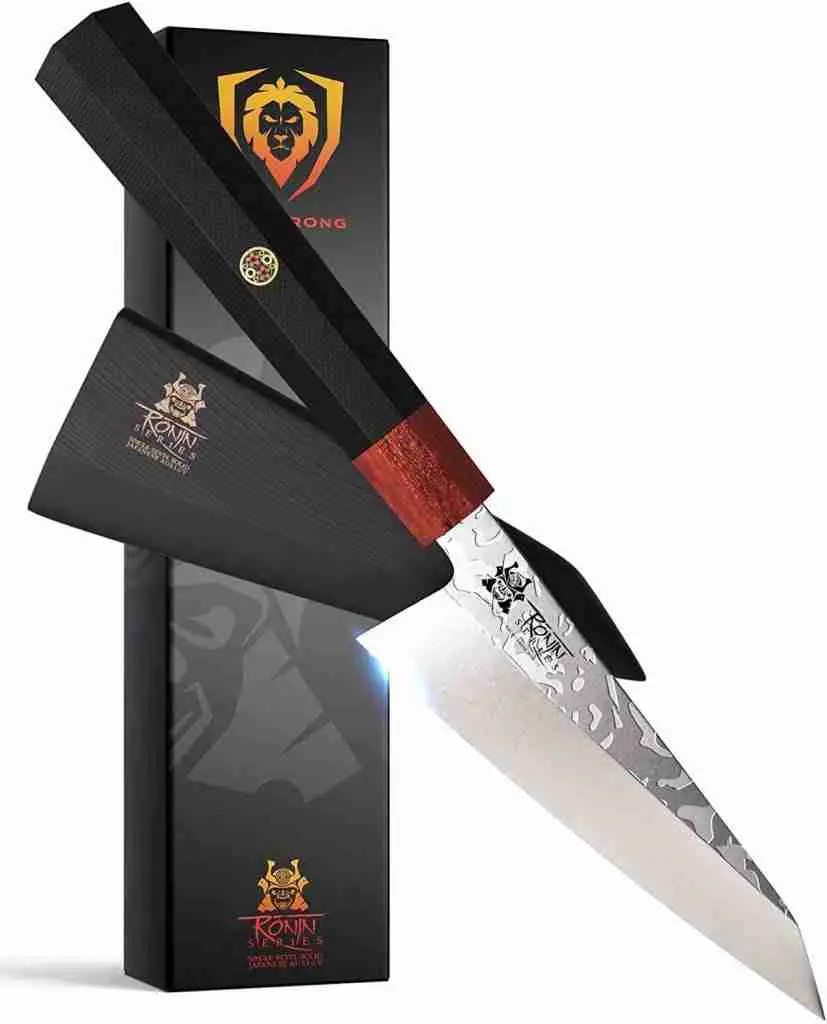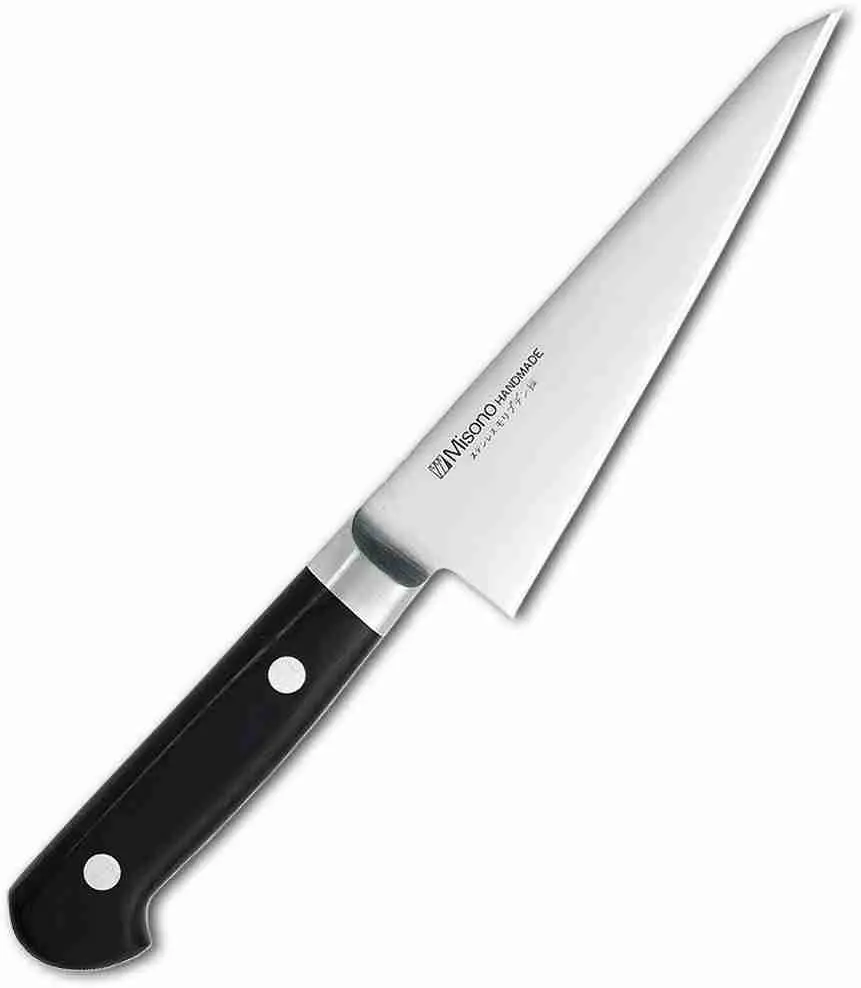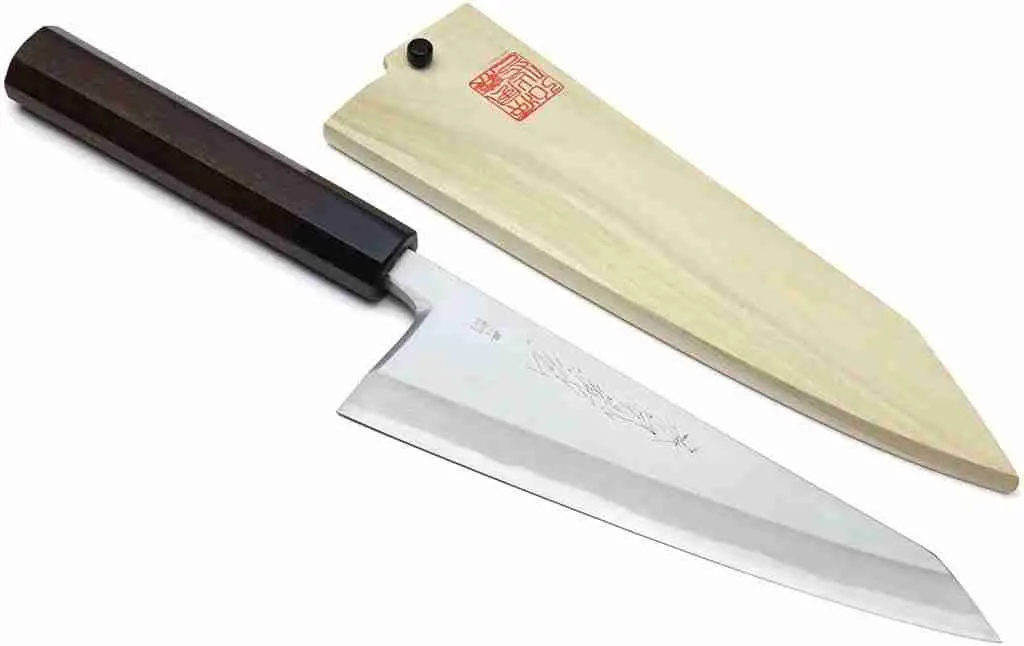In my last article, I discussed extensively Honesuki vs Boning Knife. Today, I am going to be discussing Hankotsu vs Honesuki Boning Knives.
The Hankotsu shares many similarities to the Honesuki as far as trimming meat is concerned, however, they differ in design and appearance they do exactly the same thing.
The Hankotsu is another Japanese knife that can undoubtedly get in the middle of bones, stripping the meat and the poultry; they are as good as the Honesuki and the petty knife.
The Honkotsu is designed with a sharp-pointed tip for precise easy piercing into meat, isolating the connective tissue and fats from the bone, this is the reason it is known as the bone blade.
HANKOTSU KNIFE

All Japanese premium knives are known for separating meat from bones. Japanese knives include Honesuki, Garasuki, Nakiri, Gokuyo, Gyuto, Santoku(vegetable knife), and others.
The design of the Hankotsu boning knife makes it handy for cutting meat, chicken, and also fish. The handle of the Hankotsu boning knife is non-slip giving you a comfortable grip around your fingers without fear of cut or injury.
The original intention of the Hankotsu boning knife is to slaughter hanging remains of animals by using the blade edge of the knife in a reverse knife grip.
One striking feature of the Hankotsu knife is that the heel of the knife is designed for scraping and in the case of your hands slipping from the handle, the heel isn’t sharp preventing you from any form of injury or accident.
All Japanese boning knives including the Hankotsu knife are tough, durable, very sharp, and sturdy.
Most users of the Hankotsu knife have complained of poor clearance between their knuckles and chopping board depending on the food item being cut.
The blade is famous with Westerners for undertakings, for example, boning overwhelms, ‘Frenching’ racks, and cutting slashes.
The sharp edge ends in an ‘invert tanto’ tip/’cut point’, which is ideal for penetrating through the skin and between joints or ribs.
Hankotsu knives are known for thick and thin sharp edges empowering them to perform substantial cuts, moving among ribs and joints of your ideal animal yet not bones.
The Hankotsu knife is very supple and can turn immediately when cutting around and alongside bones, and is additionally sharp enough for trimming connective tissue and fat, or for portioning meat.
READ ALSO: WHAT IS A FILLET KNIFE USED FOR?
READ ALSO: SANTOKU VS CHEF KNIFE
READ ALSO: TYPES OF BUTCHER KNIVES
HANKOTSU VS HONESUKI
Let’s see below the similarities and differences between the Hanktosu vs Honesuki knife below;
The Honesuki was designed for deboning smaller poultry. A knife with similar versatility to the western boning knife. While the Hankotsu fits better into the food preparation stage that occurs before the final cuts of meat appear in your local grocery store.

A Hankotsu is more designed for pork, beef, and anything else that needs deboning. While the Honesukis Knives can be single or double beveled, and they vary quite a bit in weight/thickness of the blade.
The Hankotsu is actually a butcher knife but works just as well for sectioning meat and poultry in the home kitchen. While the Honesuki is the more versatile made for chicken/poultry.
The Hankotsu and Honesuki knives both have comfortable handles with regular grip and non-slip.
Honesuki turns out best for boning out poultry and managing tenderloins or some other silver-cleaned meats for me. While Hankotsu is best for boning outstrips and frenching racks especially in light of the fact that there is no edge close to the base which is ideal for minimal bone scratching you may have to do.

The Hankotsu and Honesuki boning knives are easy to sharpen, maintain, durable, and are tough enough to work around bones.
Most of Honesuki’s boning knives designs are thinner at the edge than the Hankotsku boning knives.
In terms of design, the Hankotsu knife or blade has a sharp-pointed tip while the Honesuki knife has a triangular-shaped blade with a clip-point design.
Most blade lengths of the Hankotsu range from 5.7 inches to 6 inches while the Honesuki blade length ranges from 5.5-inches to 7-inches but the most common length is 6-inches.
READ ALSO: WHAT IS A BONING KNIFE USED FOR?
MISONO HANKOTSU
One of the popular Hankotsu boning knives is the Misono brand. The construction type of the Misono Hankotsu knife is a petty knife.
The Blade material of the Misono Hankotsu is made up of Stainless Steel, the Blade edge is plain and the Blade length is 15 centimeters.

The Misono Hankotsu Handmade knife is an excellent knife because it is constructed of a high carbon 13 Chrome Molybdenum stainless steel that has strong corrosion-resistance, great durability, and high cutting performance and is easy to re-sharpen.
It also has a full tang for better strength and it wears a pinned black micarta handle that is known for providing a better grip when wet.
The blade of the Misono Hankotsu is about 2.5mm thick with no blade flex and an edge that is really sharp right to around 2 inches before the reinforce.

That segment isn’t honed since the majority of the work utilizing a Hankotsu utilizes the forward piece of the edge and it can perform exactness cutting and trim utilizing its opposite tanto tip.
One and only blade which you need with regards to poultry, boning, and tiny size fishes. Best cost for the quality.
This is an ideal blade for entire hoard or fish butchering. I’ve utilized it a few times for a couple of hours all at once and it simply feels incredibly close by while getting at those troublesome cuts. Cuts through the ligament easily as well!
On the off chance that you are searching for a meat blade that will live up to your desires – this is it. Functions admirably on frozen meat too.
READ ALSO: GARASUKI VS HONESUKI
GARASUKI KNIFE
The Garasuki boning blade contrasts from the customary Western-style boning knife in a couple of key ways that set itself parts as well as dominate with its creative highlights that feature Japanese inventiveness and food.

With an incredibly sharp pointed tip that is suggestive of a snout, clean strokes of the blade can isolate poultry and meat from the bone bringing about lovely filets.
The Garasuki knife has a spine that increases in thickness towards the heel of the blade, extra heft and balance allow the blade to cut through joints and cartilage for perfect butchering.
The Garasuki boning blade is fashioned with specific consideration to make a cutting blade with a robust spine and solid heel that circular segments into a rich tip, which can move through both sensitive filets and substantial joints with artfulness.
A Garasuki is perfect for somebody who is going to process a lot of chicken.
The Garasuki is pretty much like the Honesuki Boning knife. As we all know that the Garasuki knife Originated in Japan. Garasuki is specially designed to chop, cut, and break down chickens.

Like the Honesuki, the Garasuki is suitable for people who prepare poultry and meat.
Just like every other Japanese knife, the Garasuki knife is also known for its sharp tip strength to cut, pierce the skin in tight spaces like joints.
BEST BONING KNIFE
We will all concur that a Boning blade is a key kitchen device that proves to be useful for cutting, stripping, and managing hamburger or poultry protected and quick.

You unquestionably need three blades in a Western kitchen: a French gourmet expert’s blade; an adaptable or flexible boning blade, and a bread blade, all filling different needs.
Boning blades will assist you with eliminating the fat from meat. Actually like I referenced in my previous article on Honesuki vs Boning knife and what is a Boning knife used for, choosing the best boning knife should meet the standards of being tight, adaptable, and sharp. How about we see underneath the best-suggested boning knife;
The best boning knife that can perfectly meet all your needs is the Shun Boning Knife. The Shun Boning knife is the best because Shun Boning knife has 64 layers of hardened steel that forestalls consumption obstruction.
Furthermore, the Shun knife is your go-to-blades as the length of the sharp blade guarantees you arrive at your objective and the tip is sharpened for this specific assignment.
Finally, this best Shun boning and fillet blade or knife are strongly recommended for sharpness, equilibrium, execution, and form.
JAPANESE BONING KNIFE

This Professional Japanese Boning blade is a work of art that is fabricated with an authentic Japanese super steel cutting focus edge to ensure versatility and support without chipping or dulling.
Splendidly planned for deboning, filleting, cleaning, de-scaling, and dealing with all your main fish and poultry, the restricted semi-adaptable edge generous bends up the tip to deftly work around the bone, joints, and in the skin with hazardously sharp and agile cuts with irrelevant drag.
This Japanese Boning sharp edge is also involved 66 layers of carbon perfect Damascus steel cladding and it is flexible against rusting and consumption.
The point of this Japanese Boning blade makes it is the best exact bent edge cutting edge that is ideal for cleaning, managing, and cutting.
The Ergonomic handle of the best Japanese Boning sharp edge is immune to cold, warmth, and dampness.
Your knuckle is secured as the arrangement of the Japanese Boning edge gives adequate freedom for use without knuckle obstruction.
The quality of this blade is faultless. There are no sharp edges between the handle, reinforces, and tang, a pain point for a ton of makers.
The handle of the Japanese Boning blade has a smooth changed profile that fits typically while using the standard crush hold. The restricted amount of extra weight added by the handle (end cap) in the handle, helps keep the cutting edge resting serenely in your supporting fingers.
The slight bend profile on the slicing edge makes it neighborly to shake hacking, yet you really hold the benefits of the kiritsuke edge style.
This quality is radiant, from the kitchen to the fishing boat, whether or not for careful boning, filleting, cleaning, managing, and butterflying this 6″ Regalia Emperor Series Boning and Filet edge, is crucial for any authentic culinary master.
Its brutally sharp and slim cutting edge effectively buoys or skims through meat and fat, making an ideal and basic segment of tissue from bone and skin.

1 thought on “HANKOTSU VS HONESUKI”
Comments are closed.